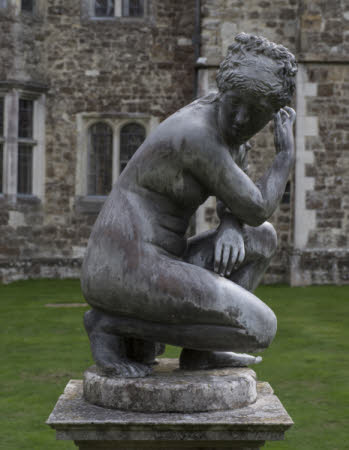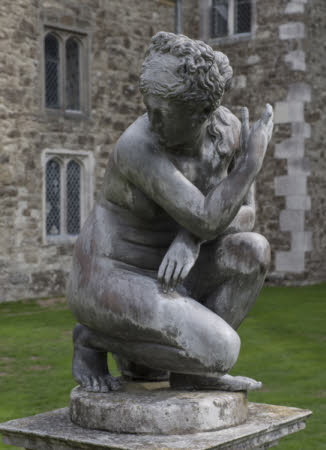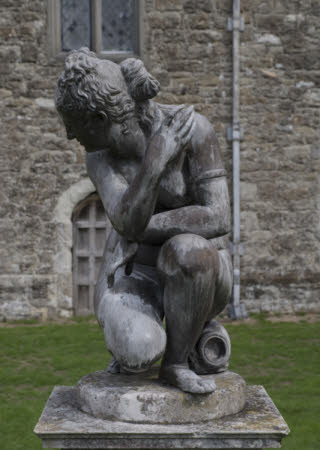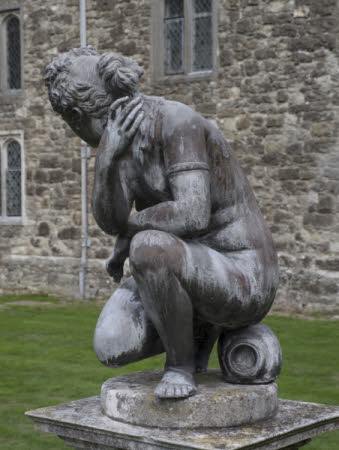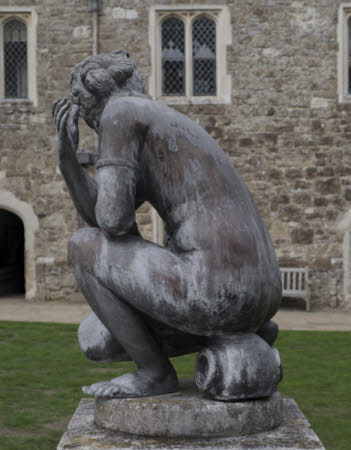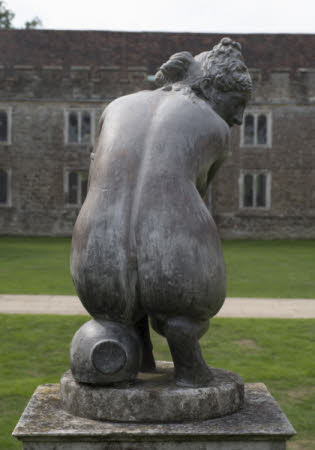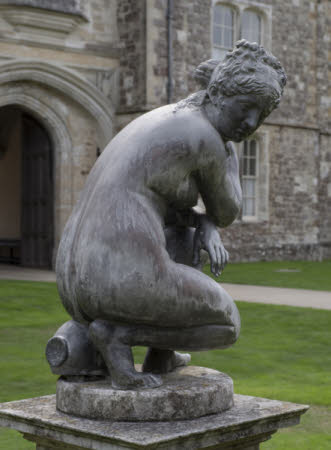Crouching Venus
attributed to John Nost I (Mechelen c.1660 – London 1710-1713)
Category
Art / Sculpture
Date
circa 1697
Materials
Lead, stone
Measurements
1100 x 660 x 460 mm
Place of origin
England
Order this imageCollection
Knole, Kent
NT 130062
Summary
Lead statue, Crouching Venus, a late seventeenth century cast, c. 1697, possibly cast by Richard Osgood (died c.1724) or John Nost the elder (d. 1729) after the antique. A nude female figure crouching and almost kneeling on her right knee, resting her left buttock on an overturned urn, her left arm crossed over her stomach and her right arm crossed in front of her breasts, her head turned to look over her right shoulder, and her hair coiled in a bun at the nape of her neck. She wears a bracelet on her upper left arm. The sculpture sits on a circular stone base which is then on top of a stone plinth.
Full description
The Crouching Venus or Crouching Aphrodite, is a Hellenistic sculpture, perhaps dating from 3rd century BC, of which several versions are known, all of which vary slightly in detail and pose. Versions are at: the Uffizi, Florence, the Musée du Louvre, Paris, in the Museo Nazionale delle Terme, Rome, among others. However another version dating from 2nd century AD in the Royal Collection (on loan to the British Museum), is the closest in style and composition to the Knole lead copy. This version was once owned by Charles I who bought it from the Gonzaga collection; it was subsequently bought by the painter Sir Peter Lely after the execution of Charles I, and is now often referred to as the Lely Venus. The statue returned to the Royal Collection after Lely's death. John Nost the Elder (d.1729) carved a version of the Crouching Venus after the antique in marble in 1702 for Andrew I Archer for Umberslade Hall, Warwickshire; Nost's statue appears to be closely based on the Royal Collection example. The statue is now owned by the Victoria and Albert Museum, acquired in 2012. The lead statue at Knole appears to predate Nost's marble statue by a few years: a receipt dated 6 September 1697 from Richard Osgood, an English sculptor (died c.1724) bills the Earl of Dorset for 'Statuary work', including a bill 'For the case for the Venus and pedestal that went to Knowell'. Osgood also billed the Earl of Dorset 'For Makeing a mold and casting the Susanna of hard mettel', 'For the Gladiator as agreed for' and 'For a Large stone plinth and Shield wth my Lords Armes'. It is unknown what the statue of Susanna is as it is no longer at Knole, but the reference to the Gladiators refers to NT 130066. The bill does not make clear if Osgood provided the lead casts of the Gladiators and the Crouching Venus, or just supplied the plinths and the shield with the Sackville arms for the Gladiators. Osgood owned premises at Hyde Park Corner, London, working alongside other leading lead figure manufacturers including John Nost the Elder, Edward Hurst and Josias Iback. Osgood and Nost collaborated on a commission for Hampton Court Palace in 1701, and it is also possible that they collaborated on the two large lead sculptures at Knole. Nost may have supplied the lead cast for the Crouching Venus, for which Osgood made the packing case and the stone pedestal; as noted above, Nost produced a marble of the Crouching Venus in 1702 and may have produced a mold for a version in lead as early as 1697. Anna Moore (July 2018)
Provenance
A bill for 'Statuary work' dated 6 September 1697 from the sculptor Richard Osgood (died c.1724) bills Charles Sackville, 6th Earl of Dorset (1643-1706) 'For the case for the Venus and pedestal that went to Knowell', as well as 'For the Gladiator as agreed for, For a Large stone plinth and Shield wth my Lords Arms'. A lead statue was recorded as being in the Green Court in the 1706 inventory of Knole, 'One Leaden Statue on a pedestall'. This could refer to either the Crouching Venus (NT 130062) or the Borghese Gladiator (NT 130066). The 1765 inventory records two statues in the Green Court: 'two Statues in the Green-Court'. On loan to the National Trust from the Sackville Trust.
Makers and roles
attributed to John Nost I (Mechelen c.1660 – London 1710-1713), sculptor attributed to Richard Osgood (died c. 1724), sculptor
References
Haskell and Penny 1981: Francis Haskell and Nicholas Penny, Taste and the Antique, The Lure of Classical Sculpture 1500 - 1900, New Haven and London, 1981, 86, fig. 171 Trusted 2012: Marjorie Trusted, 'Two eighteenth-century sculpture acquisitions for the Victoria and Albert Museum, London' in The Burlington Magazine Vol. 154, No. 1316 (November 2012), pp. 773-779
